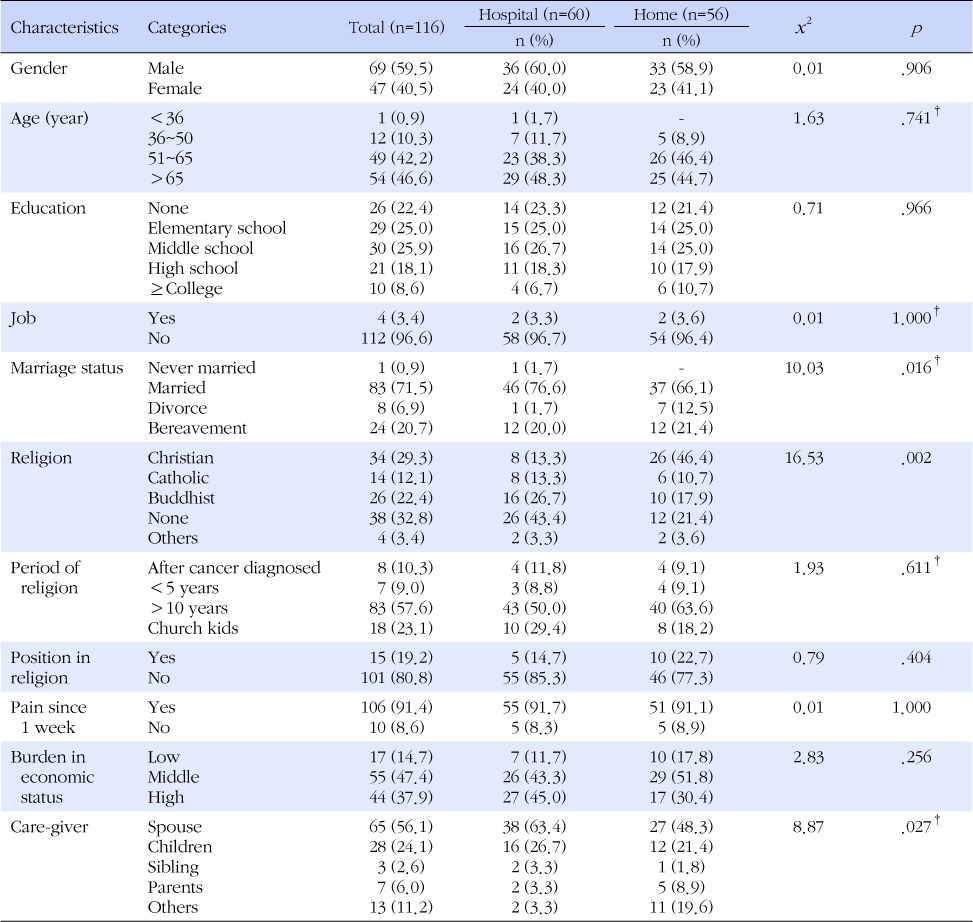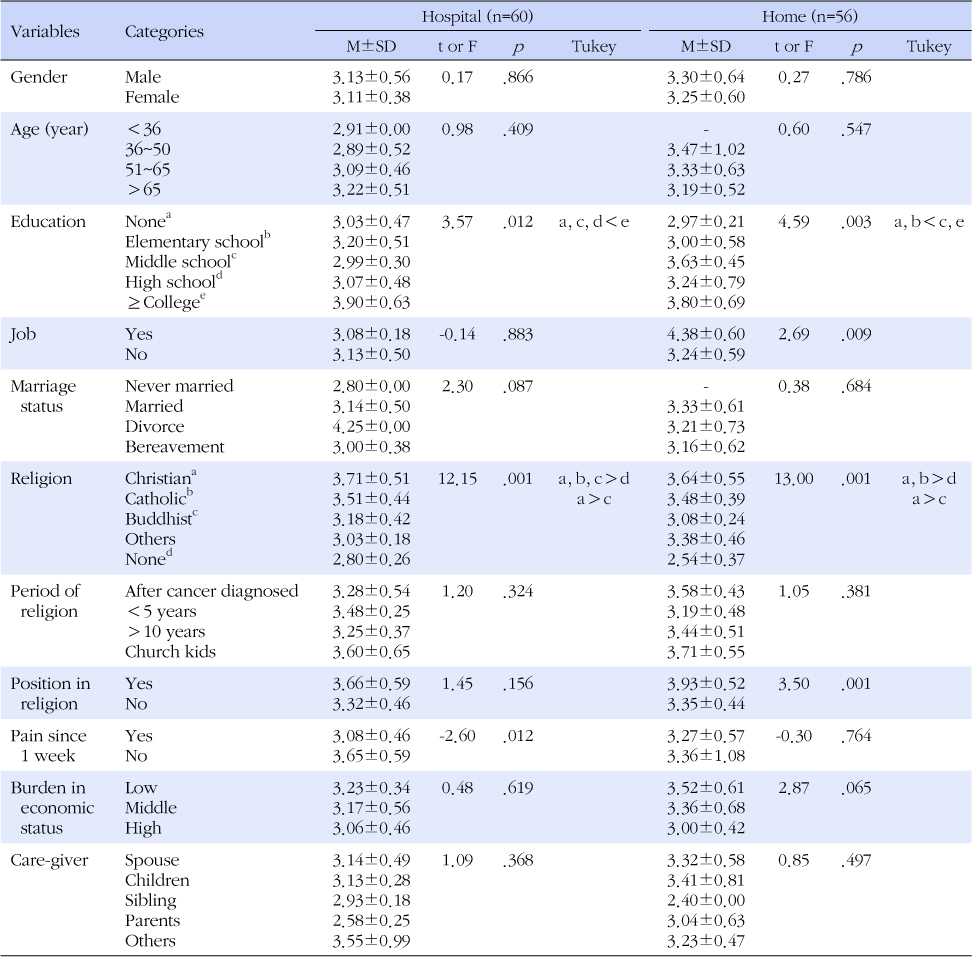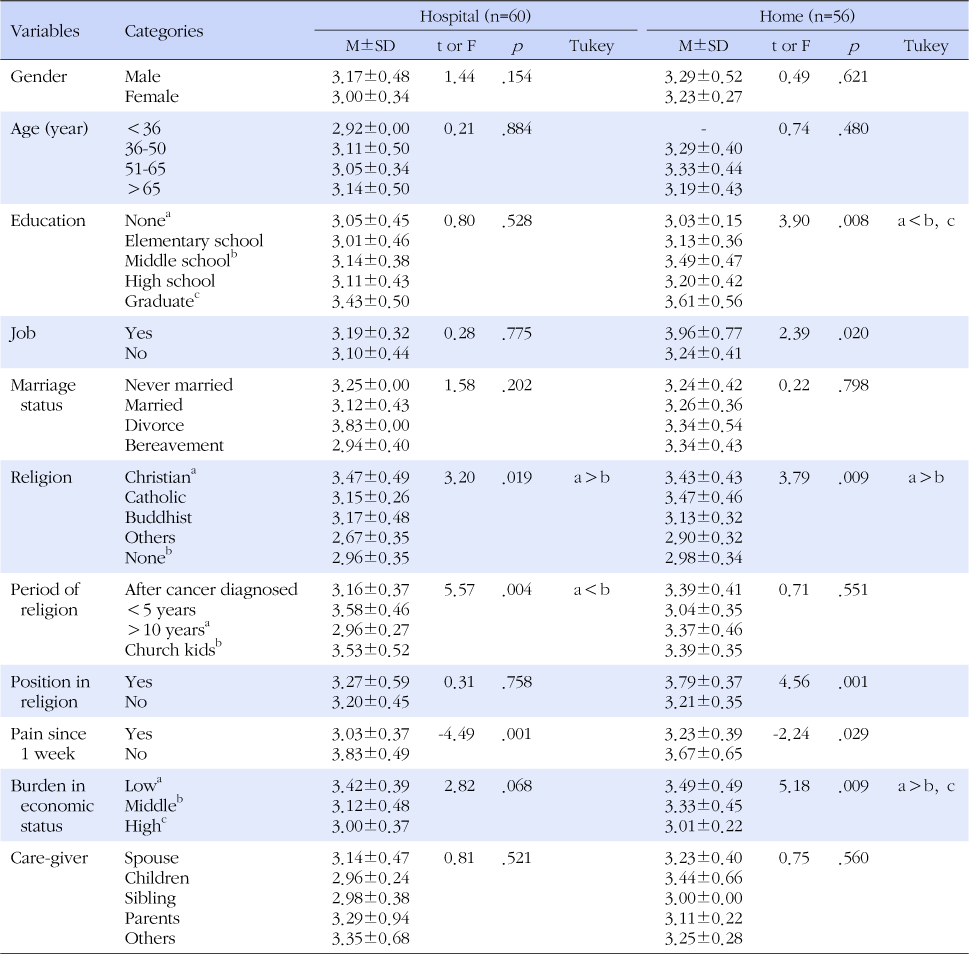Articles
- Page Path
- HOME > J Korean Acad Community Health Nurs > Volume 24(3); 2013 > Article
-
Original Article
- Comparison in Spiritual Well-being and Quality of Life between Hospital and Home Hospice Patients
- Bok Hee Kim, Heeok Park
-
Journal of Korean Academy of Community Health Nursing 2013;24(3):292-301.
DOI: https://doi.org/10.12799/jkachn.2013.24.3.292
Published online: September 30, 2013
1College of Nursing, Keimyung University, Daegu · Pohang St. Mary's Hospital, Pohang, Korea.
2College of Nursing · Research Institute of Nursing Science, Keimyung University, Daegu, Korea.
• Received: May 8, 2013 • Accepted: September 8, 2013
© 2013 Korean Academy of Community Health Nursing
This is an Open Access article distributed under the terms of the Creative Commons Attribution Non-Commercial License (http://creativecommons.org/licenses/by-nc/3.0/) which permits unrestricted non-commercial use, distribution, and reproduction in any medium, provided the original work is properly cited.
- 688 Views
- 3 Download
- 5 Crossref
Abstract
-
Purpose
- The purpose of this study was to compare the spiritual well-being and quality of life between hospital and home hospice patients.
-
Methods
- A total of 116 patients from 4 hospice hospitals in D city and P city participated in this study from January to April 2012. To measure spiritual well-being, an instrument developed by Paloutzian and Ellison (1982) and revised by Park (2005) was used. To measure quality of life, an instrument developed by Cho (1993) and revised by Sun (2003) was used. The data were analyzed by using descriptive statistics, t-test, χ2-test, and ANCOVA.
-
Results
- Spiritual well-being and quality of life were higher in home hospice patients than in hospital hospice patients, but they were not statistically significant. Higher education and having religion were significantly related to higher spiritual well-being in both groups. Having religion and pain history for the past one week were significantly related to higher quality of life in both groups.
-
Conclusion
- For hospice patients, participation in religious activities needs to be encouraged to improve their spiritual well-being and quality of life. Assessing the hospice patients' pain history with close observation and managing the pain are suggested.
Table 2Difference in Spiritual Well-being and Quality of Life between Hospital Hospice Patients and Home Hospice Patients (N=116)


- 1. Ahn KA. A study on the attitudes and preparation for death among the aged in rural areas. J Res Inst Hosp Palliat Care. 2002;6:39–52.
- 2. Bae SH, Park JS. Symptom distress and spiritual well-being in patients with cancer according to illness and treatment. J Korean Acad Fundam Nurs. 2007;14(4):457–465.
- 3. Byun HS, Kim GD. Impacts of fatigue, pain, anxiety, and depression on the quality of life in patients with breast cancer. Asian Oncol Nurs. 2012;12(1):27–34. ArticlePDF
- 4. Cho H. A study on the development of Korean hospice program. Seoul: Seoul National University; 1993. Unpublished doctoral thesis.
- 5. Choi SE, Kang ES. Effects of holistic hospice nursing intervention program on self esteem and spiritual wellbeing for inpatients of hospice palliative care unit. Korean J Hosp Palliat Care. 2009;12(4):209–219. Article
- 6. Choi YS. The retrospect and prospect of home hospice and palliative care. In: Hahn JY, editors. Hospital-based home hospice care business. Seoul: Korean Hospice and Palliative Nurses Association; 2011. p. 41–44.
- 7. Chung JH. The retrospect and prospect of home hospice and palliative care. In: Hahn JY, editors. The retrospect and prospect of home hospice care in Korea. Seoul: Korean Hospice and Palliative Nurses Association; 2011. p. 41–44.
- 8. Hong YS, Yeom CH, Lee KS. Past, present of hospice in Korea. Korean J Hosp Palliat Care. 2000;3(2):113–117.
- 9. Jang IS, Kim SM. Study on spiritual well-being of elderly people in the community. J Korean Gerontol Nurs. 2003;5(2):193–204.
- 10. Kang MH. A study on spiritual well-being and factors affecting of spiritual well-being in the elderly. Daegu: Kyungpook National University; 2009. Unpublished master's thesis.
- 11. Kim CN, Song MO. A study on the spiritual wellbeing of the hospice patients. J Korea Community Health Nurs Acad Soc. 2003;17(2):255–265.
- 12. Kim HK. The comparison of characteristics of family members by the generation and the type of living arrangement. Soc Welf Policy. 2006;27:55–77.
- 13. Koh SJ. The retrospect and prospect of home hospice and palliative care. In: Hahn JY, editors. Developing standard service for home hospice care. Seoul: Korean Hospice and Palliative Nurses Association; 2011. p. 47–66.
- 14. Lee TW, Lee WH, Kim MS. Comparison of the costs of care and nursing services for terminally ill patients receiving home hospice care in comparison to institutional care. J Korean Acad Nurs. 2000;30(4):1045–1054. ArticlePDF
- 15. Moon DH, Lee MA, Koh SJ, Choi YS, Kim SH, Yeom CH. Doctor's attitudes toward hospice and palliative care for terminal cancer patients. Korean J Hosp Palliat Care. 2006;9(2):93–100.
- 16. National Cancer Center. Definition of hospice and palliative care 2011;Retrieved October 23, 2011. from http://hospice.cancer.go.kr
- 17. National Hospice and Palliative Care Organization. Preamble to NHPCO standard of practice & hospice philosophy statement 2011;Retrieved October 23, 2012. from http://www.nhpco.org/i4a/pages/index.cfm?pageid=5308
- 18. Oh PJ. A study of the correlation between spiritual well-being and quality of life in people with cancer. J Korean Acad Adult Nurs. 1997;9(2):189–198.
- 19. Paloutzian RF, Ellison CW. Loneliness: A source book of current theory, research and therapy. In: Peplau LA, Perlman D, editors. Loneliness, spiritual well-being and the quality of life. New York: Wiley Interscience; 1982. p. 224–237.
- 20. Park JS. A correlation study among loneliness, spiritual well-being, and quality of life in the elderly. Seoul: Korea University; 2005. Unpublished master's thesis.
- 21. Park T, Song HH, Ra JR, Seo IO, Cho YY, Park MH, et al. Quality of life changes in patients admitted to the hospice unit. Korean J Hosp Palliat Care. 2000;3(1):18–27.
- 22. Ro YJ, Kim CG. A comparison of quality of life between the families of hospital hospice patients and those of home-based hospice patients. J Korean Acad Nurs. 1998;28(3):773–785. ArticlePDF
- 23. Ro YJ, Kim CG, Lee YS. An analysis of nursing research related to quality of life reported in Korea from 1987 to 1996. J Korean Acad Adult Nurs. 1999;11(4):743–757.
- 24. Statistics Korea. The causes of death 2010;Retrieved October 23, 2012. from http://www.kostat.go.kr
- 25. Sun JJ. Changes in pain and quality of life of terminal cancer patients through hospice home care. Gwangju: Chonnam National University; 2003. Unpublished master's thesis.
- 26. Yong JS. Analysis of major complaints, reasons for referring home hospice, and nursing diagnosis of home hospice patients. J Res Inst Hosp Palliat Care. 2005;9(1):8–17.
- 27. Yoo SY. The effects of hospice care on quality of life in terminal cancer patients. Seoul: Yonsei University; 2001. Unpublished master thesis.
- 28. Yoon MO. The effect of spiritual nursing intervention on the meaning of life and spiritual distress of the terminal cancer patients. J Res Inst Hosp Palliat Care. 2004;8:54–67.
Figure & Data
References
Citations
Citations to this article as recorded by 

- A Systematic Review of Measurement Properties of Spirituality related Assessment Tools Published in Korean Journals
Il-Sun Ko, Jin Sook Kim, Soyoung Choi
Journal of Korean Academy of Fundamentals of Nursing.2021; 28(1): 133. CrossRef - Home-Based Hospice Care Provided by a Free-Standing Hospice Center: Patients’ Characteristics and Service Conditions
Hyoung Suk Kim, Kyung Ja June, Young Sun Son
The Korean Journal of Hospice and Palliative Care.2016; 19(2): 145. CrossRef - Introduce and Promote the Home-based Hospice and Palliative Care
Jung-Kyu Choi, Yoon-Hee Tae, Young-Soon Choi
The Korean Journal of Hospice and Palliative Care.2015; 18(3): 219. CrossRef - Nursing Need and Satisfaction of Patients in Hospice Ward
Jung Ah Kim, Kyunghee Kim, Hee Sun Kang, Ji-su Kim
The Korean Journal of Hospice and Palliative Care.2014; 17(4): 248. CrossRef - Experience of Home-Based Hospice Care of Terminal-Cancer Patients
Boon Han Kim, Hwa Jung Kang
The Korean Journal of Hospice and Palliative Care.2014; 17(4): 223. CrossRef

 KACHN
KACHN



 PubReader
PubReader Cite
Cite

